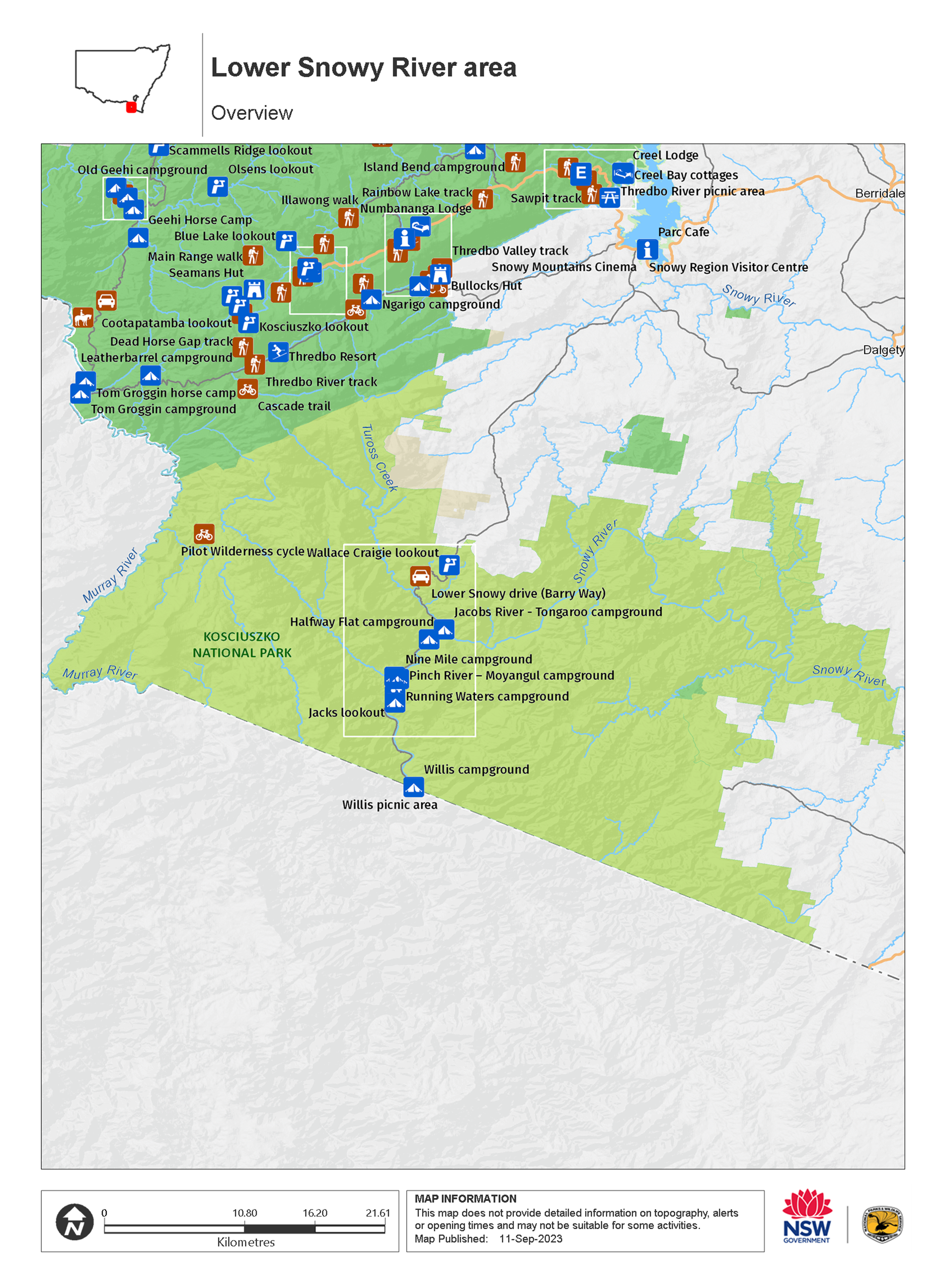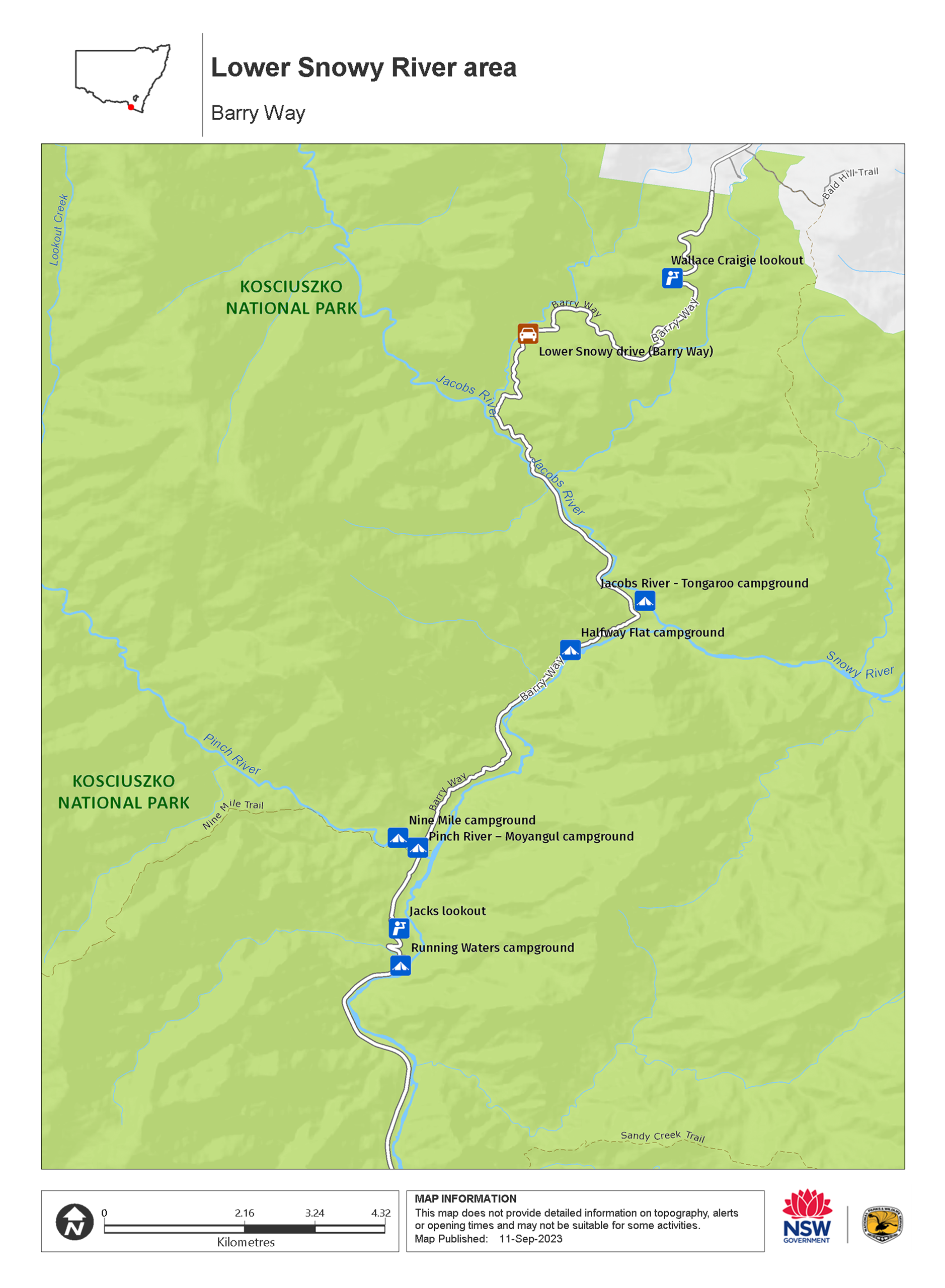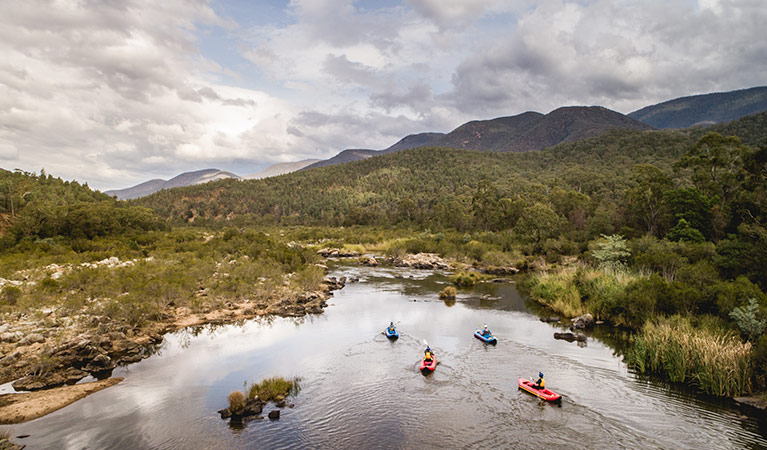Lower Snowy River area
Kosciuszko National Park
Overview
The Lower Snowy River area embraces the wild south of Kosciuszko National Park. Camp by the Snowy River, explore the scenic trails on a walk, bike or horse ride. See another side of the Snowy Mountains.
Read more about Lower Snowy River area
The Lower Snowy River is only 40km south of Jindabyne’s Snowy Region Visitor Centre but feels a world away.
Find a secluded site at a campground by the banks of the fabled Snowy River. Easy access to the river and its sandy beaches, plus a mild and dry climate, make this area perfect for fishing, paddling and swimming.
Set out on a bushwalk, horse or mountain bike ride along shady trails framed by towering eucalypts, cypress pine and yellow wattle. The long Pilot Wilderness mountain bike ride offers a challenge for well-prepared adventurers.
The best way to explore is along the sprawling Lower Snowy drive (Barry Way) from Jindabyne to the Victorian border. It follows the old stock route through the steep-sided Snowy River gorge. There are scenic stopping points along the way, like panoramic Jacks lookout and historic Willis picnic area.
There’s also plenty of bird watching and wildlife spotting. By day you might see red-necked wallabies, kangaroos and emus. Spot rainbow bee-eaters or peregrine falcons. As the sun sets, keep an eye out for wombats, possums and, if you’re lucky, the endangered spotted-tailed quoll.
Local alerts
For the latest updates on fires, closures and other alerts in this area, see https://www.nationalparks.nsw.gov.au/visit-a-park/parks/lower-snowy-river-area/local-alerts
Map

Map

Map legend

Contact
- in Kosciuszko National Park in the Snowy Mountains region
The Lower Snowy River area is open all year, but some roads and trails may close due to weather conditions or park management issues.
-
No park entry fees apply in the Lower Snowy River area. See vehicle entry fees for other areas in Kosciuszko National Park.
Buy annual pass. -
-
Snowy Region Visitor Centre
02 6450 5600
Contact hours: 8.30am to 5pm daily. Closed Christmas Day. - 49 Kosciuszko Road, Jindabyne NSW 2627
-
Email: srvc@environment.nsw.gov.au
-
Snowy Region Visitor Centre
Visitor info
All the practical information you need to know about the Lower Snowy River area.
Maps and downloads
Visitor centre
-
Snowy Region Visitor Centre
49 Kosciuszko Road, Jindabyne NSW 2627 - 8.30am to 5pm daily. Closed Christmas Day.
- 02 6450 5600
Nearby towns
Jindabyne (40 km)
For those heading to the Snowy Mountains snowfields,
Learn more
Lower Snowy River area is a special place. Here are just some of the reasons why:
A sanctuary for wildlife

The Lower Snowy River is a haven for plants and animals, including rare species. While kangaroos, swamp wallabies and wombats are common, keep an eye out for the endangered spotted-tailed quoll, shy platypus, short-beaked echidna, and impressive wedge-tailed eagles. White box and cypress pine are common in the dry woodlands, as are grass trees - ancient flowering plants that have existed since dinosaurs roamed Australia.
Drive the old drovers route

In the 1800s, Lower Snowy drive (Barry Way) formed the stock route for sheep and cattle travelling from summer grazing, in the high alpine country, to Bairnsdale markets. The eagle-eyed can spot tree markers and the remains of old stockyards near Jacobs River campground. Before federation, a customs house stood at Willis picnic area, for the Victorian Government to collect taxes on cattle crossing the border.
- Lower Snowy drive (Barry Way) Lower Snowy drive is a sprawling road trip that takes travellers past picnic spots, swimming holes, campgrounds and lookouts in the Snowy River valley.
World-class wilderness

In recognition of Kosciuszko's unique value as a conservation area, it’s been named a UNESCO Biosphere Reserve. More than half of the park, over 350,000ha (almost 865,000 acres), has been declared wilderness, including Pilot Wilderness and Byadbo Wilderness in the Lower Snowy River area. Pilot Wilderness, which rises from just over 200m in the Lower Snowy River valley to 1830m at The Pilot mountain, makes up over 20 per cent of this protected area.
- Pilot Wilderness mountain bike ride (Alpine Way to Barry Way) Pilot Wilderness mountain bike ride in Kosciuszko National Park is a challenging, long-distance mountain bike trail that is suited to experienced mountain bike riders.
- Snowy River whitewater adventure tours Paddle down the famed Snowy River on a guided tour with Wieland Adventures. These whitewater rafting expeditions are a thrilling way to explore this remote corner of Kosciuszko National Park.
- Snowy River wilderness experience Paddle the iconic Snowy River on a 5-day adventure in remote Kosciuszko National Park. Camp in Byadbo Wilderness with your Aboriginal guide on this unforgettable experience.
Plants and animals protected in this park
Animals
-

Yellow-tailed black cockatoo (Calyptorhynchus funereus)
The yellow-tailed black cockatoo is one of the largest species of parrot. With dusty-black plumage, they have a yellow tail and cheek patch. They’re easily spotted while bird watching, as they feed on seeds in native forests and pine plantations.
-

Wedge-tailed eagle (Aquila audax)
With a wingspan of up to 2.5m, the wedge-tailed eagle is Australia’s largest bird of prey. These Australian animals are found in woodlands across NSW, and have the ability to soar to heights of over 2km. If you’re bird watching, look out for the distinctive diamond-shaped tail of the eagle.
-

Emu (Dromaius novaehollandiae)
The largest of Australian birds, the emu stands up to 2m high and is the second largest bird in the world, after the ostrich. Emus live in pairs or family groups. The male emu incubates and rears the young, which will stay with the adult emus for up to 2 years.
-

Swamp wallaby (Wallabia bicolor)
The swamp wallaby, also known as the black wallaby or black pademelon, lives in the dense understorey of rainforests, woodlands and dry sclerophyll forest along eastern Australia. This unique Australian macropod has a dark black-grey coat with a distinctive light-coloured cheek stripe.
-

Platypus (Ornithorhynchus anatinus)
One of the most fascinating and unusual Australian animals, the duck-billed platypus, along with the echidna, are the only known monotremes, or egg-laying mammals, in existence. The platypus is generally found in permanent river systems and lakes in southern and eastern NSW and east and west of the Great Dividing Range.
-

Short-beaked echidna (Tachyglossus aculeatus)
One of only 2 egg-laying mammals in the world, the short-beaked echidna is one of the most widespread of Australian native animals. Covered in spines, or quills, they’re equipped with a keen sense of smell and a tube-like snout which they use to break apart termite mounds in search of ants.
-

Tawny frogmouth (Podargus strigoides)
Found throughout Australia, the tawny frogmouth is often mistaken for an owl due to its wide, powerful beak, large head and nocturnal hunting habits. The ‘oom oom oom’ call of this native bird can be heard echoing throughout a range of habitats including heath, woodlands and urban areas.
-

Common brushtail possum (Trichosurus vulpecula)
One of the most widespread of Australian tree-dwelling marsupials, the common brushtail possum is found across most of NSW in woodlands, rainforests and urban areas. With strong claws, a prehensile tail and opposable digits, these native Australian animals are well-adapted for life amongst the trees.
-

Bare-nosed wombat (Vombatus ursinus)
A large, squat marsupial, the Australian bare-nosed wombat is a burrowing mammal found in coastal forests and mountain ranges across NSW and Victoria. The only other remaining species of wombat in NSW, the endangered southern hairy-nosed wombat, was considered extinct until relatively recently.
-

Superb lyrebird (Menura novaehollandiae)
With a complex mimicking call and an elaborate courtship dance to match, the superb lyrebird is one of the most spectacular Australian animals. A bird watching must-see, the superb lyrebird can be found in rainforests and wet woodlands across eastern NSW and Victoria.
-

Spotted-tailed quoll (Dasyurus maculatus)
The spotted-tailed quoll is the largest remaining carnivorous marsupial on the Australian mainland. It’s protected as a vulnerable species in NSW.
Plants
-

Grass tree (Xanthorrea spp.)
An iconic part of the Australian landscape, the grass tree is widespread across eastern NSW. These Australian native plants have a thick fire-blackened trunk and long spiked leaves. They are found in heath and open forests across eastern NSW. The grass tree grows 1-5m in height and produces striking white-flowered spikes which grow up to 1m long.
-

Old man banksia (Banksia serrata)
Hardy Australian native plants, old man banksias can be found along the coast, and in the dry sclerophyll forests and sandstone mountain ranges of NSW. With roughened bark and gnarled limbs, they produce a distinctive cylindrical yellow-green banksia flower which blossoms from summer to early autumn.
-

Scribbly gum (Eucalyptus haemastoma)
Easily identifiable Australian native plants, scribbly gum trees are found throughout NSW coastal plains and hills in the Sydney region. The most distinctive features of this eucalypt are the ‘scribbles’ made by moth larva as it tunnels between the layers of bark.
Environments in this area
What we're doing
Lower Snowy River area has management strategies in place to protect and conserve the values of this park. View the detailed park and fire management documents. Here is just some of the work we’re doing to conserve these values:
Preserving biodiversity
Kosciuszko National Park plays an important role in conserving NSW’s biodiversity by protecting its vulnerable, threatened and endangered species. Conservation activities carried out in the Lower Snowy River area of the park include monitoring habitats, distribution and population of species such as spotted-tail quolls and box pine.
Managing weeds, pest animals and other threats
Pests and weeds have a significant impact on the ecosystems and habitats within Kosciuszko National Park. Reduction of pest species, such as deer, horses and goats, is an important part of the work NSW National Parks and Wildlife Service (NPWS) does to protect the integrity of the Pilot and Byadbo wilderness areas, water quality, and native animal and plant biodiversity.
Managing fire
NSW is one of the most bushfire prone areas in the world due to our climate, weather systems, vegetation and the rugged terrain. NPWS is committed to minimising the likelihood and impact of bushfires via a strategic program of fire research, fire planning, hazard reduction, highly trained rapid response firefighting crews and community alerts.
Developing visitor facilities and experiences
NPWS is committed to developing facilities for the enjoyment and safety of visitors to Kosciuszko National Park. Visitor feedback and environmental sustainability are key considerations in park maintenance, and upgrades are ongoing. Campgrounds, picnic areas, trails and lookouts are continually maintained and upgraded, and NPWS regularly reviews the park’s recreational opportunities, identifying areas for improvement or addition. Hazard assessments are also ongoing.
Kosciuszko National Park has achieved Australia’s first Ecotourism Destination Certification, through Ecotourism Australia, recognising best practice sustainable tourism and visitation in protected areas.

